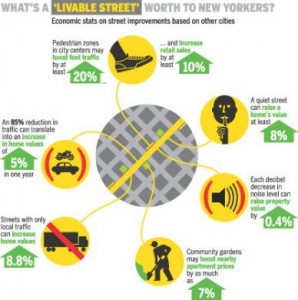 By now, if you read this blog regularly, it can be no surprise that what we do that is good for the habitat we depend upon for our health, happiness and security is most often good for our quality of life.
By now, if you read this blog regularly, it can be no surprise that what we do that is good for the habitat we depend upon for our health, happiness and security is most often good for our quality of life.
Gardens in the streets instead of parking places for carbon-emitting cars mean a 7% increase in your property value. Walking-only zones in city centers increase retail sales in those areas by up to 20%. Happier planet, in other words, happier people.
These results come from a recent report from Transportation Alternatives (TA), the New York City group–of which I am a board member–that advocates both for livable streets and for safe and easy biking, walking and transit use.
Citing the TA report, the New York Observer writes:
- In Grand Rapids, Mich., property values increased by nearly one-third following traffic-calming measures.
- An effort to make downtown Melbourne, Australia, more livable spurred a 50 percent pedestrian volume increase over 10 years. The number of outdoor cafes quadrupled and the number of cafe seats nearly tripled.
- After two through-traffic streets in Cambridge, England, were closed, daily traffic levels dropped by more than 7,300 vehicles with no effect on retail.
- A survey of shoppers in central London retail districts found that those who walked to stores spent much more over the week than those who drove.
As the Observer says, and I have to assume this would be true of most cities:
“The gathering evidence suggests a sunny mantra: Design additional livable streets and New Yorkers would come and property owners and retailers would benefit.”
To read the TA report, “Streets to Live By: How Livable Street Design Can Bring Economic, Health and Quality of Life Benefits to New York City,” click here.